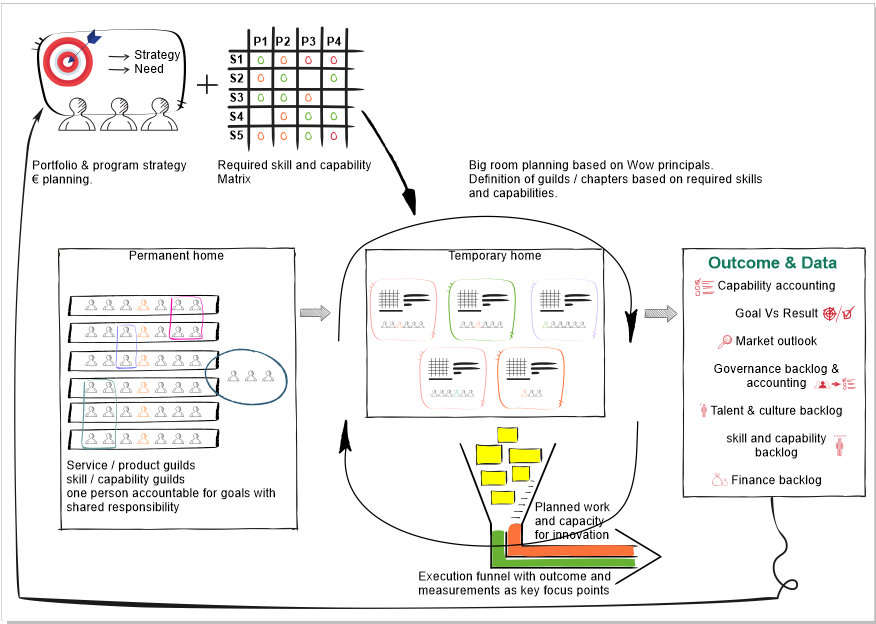An Overview of the Knowledge Network Operating Model : Part 1


SAKET BIVALKAR
Business Coach
As we covered in the previous article of how I understand organisations article here, ultimately organisations are the makeup of Product/Service dimensions feeding into Market changes that affect the People within the organisation to deliver the expected value, over to the processes or how the people collaborate, altogether defining an organisations Culture.
Likewise, we established that overperforming organisations adapt rather than shelter externalities, advocating for nimbleness rather than rigidity.
Throughout the remainder of this article series, you will see cohesion in how this permeates everything: and this overview article is no different.
Pablo Picasso’s lifelong struggle was being a perfectionist. Picasso was known for never finishing a painting (or at least only a few handfuls of them). He said that “If it were at all possible… there would never be a ‘finished’ canvas but just different states of a single painting.”
I, together with Robert Keidel, see organisations the same way. You will never have a “finished” organigram, hierarchical structure, or organisational design because circumstances change to force the organisation to change. The ecology shifts, so the organisation must adapt. The Knowledge Network Operating Model, or KNOM, is designed to continually be adaptive, always changing based on circumstances. Allegorically, the KNOM will be different canvases of a single painting never fully completed.
Before we go into the five elements of KNOM, it is helpful to see the overarching design as a baseball team. Here each player is pooled differently at their station based on skill level and responsibility, collaborating towards the same goal, but are at the same time interdependent and autonomous.
“a model of individual/unit autonomy…” (Keidel, 1997) in that it is both decentralised and adaptable based on changes in the market environment and product changes: how the game itself unfolds.

The Knowledge Network Operating Model is designed of five elements: progressing in a set order illustrated below, feeding back onto itself in an adapting loop.
Element 1: Permanent Home
The larger structure of the organisational KNOM design is where the people will gather, re-evaluate, learn, and share skills and capabilities. Here different Guilds 1 of people are banded together in the joint furtherance of their professional interests; collaborating autonomously with other Guilds: similar to how Micro Enterprises function in the Rendanheyi model.
This Guild design also enables people from different guilds to exchange skills and transfer crucial desired explicit and tacit knowledge to each other, furthering the organisation. Whereas leaders will handle conflict resolutions and making sure efficient continuity of work is achieved related to specific and relevant time scales.
Lastly, the makeup of people will be opened to join each guild in the Permanent Home based on which skills and capabilities desired to learn or teach. In this way, the people in Permanent Home gets presented and exposed to the Skills/Capabilities Matrixes in Temporary Home that then reveal for the individual if they would want to change Guilds. This is the same methodology for the Guild Leaders, although as mentioned they are accountable and beholden to smooth transitions of people, so they might have to complete certain time horizons before being able to switch Guild.
Element 2: Strategy Formation & Program Development
The second element of KNOM is Strategy Formation. Here is where experts and managers (usually from each Guild in the Permanent Home) get together to design vision strategy and program changes with a time horizon of 2 to 3 months.
During such iteration and towards the end of a projects cycle, data and outcome, depicted in element 5, are gathered. Information that determines hard skills and soft capabilities found lacking during the last iteration and strategy formation. This reassessment of skills and capabilities feeds into future projects and corresponding Skill Matrixes required.
Hard skills are defined as the operational skills needed to complete each program, whereas the soft capabilities are longer-termed, intellectual in nature, for each program. A reinforcing feedback loop of evaluated and taught skills and capabilities which is one of the central features of the KNOM design of course corrections and adaptiveness are built-in into the model itself.
Element 3: Big Room Planning & Temporary Home
The programs with their corresponding Skill Matrixes are then posted on a board: effectively creating a centralised place for all the organization’s programs.
Then, individuals from each decentralised guild in the Permanent Home adopt a chosen program and attach themselves to one or more of the skills or capabilities required. This creates the result that temporary teams are formed on each program with people with different skillsets and capabilities. Effectively, opening for both extrinsic and intrinsic innovation dynamics continually improving the completion of each program.
Element 4: Execution Pipeline
After a program is created into a Minimum Valuable Product, it moves into an execution process of the pipeline. Here an appointed leader from the Permanent Home adopted to a temporary program is responsible for the execution of the programs’ final result.
But the overall accountability of the Execution Pipeline itself comes from the Expert Guild comprising of Domain Experts in each Guild in the Permanent Home.
Element 5: Outcome & Data
“You don’t plan strategy – you learn strategy.”
The function of this element is such that insights and data are gained to feed into Element 2: Strategy Formation & Program Development. In effect, creating a positive, iterative, and adaptable feedback loop directly based on the Product/Service and Market changes affecting each of the program’s results.
In effect, this translates to continual improvement every two to three months.
Brief examples of the data gathered are governance, innovation, finance, and process improvement backlog. We will cover these and more in its own article.
In short
These five elements are the Knowledge Network Operating Model design and the overview of how it functions and the interaction between each element.
But also, how it is designed on everchanging adaptability and on how I see organisations and their consecutive parts jointly generating value.
The KNOM design is a decentralised, adaptable, and agile operating model, as it is directly linked with the product(s) or service(s) the company offers. Furthermore, each program’s assessment feedback loop ties into the operating model itself, modifying both future programs and skills matrixes. This inadvertently furthers the temporary program teams and the Guilds in Permanent Home, advancing the people’s skills and capabilities continually.
Knowledge Network Operating Model, is designed to allow a company to continuously re-invent itself. As the market changes, so too can the organisation by innovating the product or service offered. The KNOM operating model is designed with this in mind, as it allows for a company to change with the market and ensures that it does not become obsolete.
The upcoming articles in this series will be a detailed analysis and reflection on each element in-depth, one element per article. This is ultimately for you to discover how this successful KNOM design works and how overperformers succeed utilising it.
Harnessing the Power of Management Innovation
Discover the transformative power of management innovation with Versatile Consulting in driving business success. Lets innovative management practices that can create a competitive edge, foster a culture of innovation, and navigate the challenges of today’s dynamic business environment.
Understanding Organisational Culture: Symptoms and Impact.
Organizational culture is a complex and multifaceted concept that influences the behavior of individuals within an organization. By understanding the different interpretations of culture and the symptoms of different types of organizational cultures, organizations can take steps to create a positive and healthy work environment that fosters collaboration, innovation, and growth.
KNOM Element Five, data through intuition and intuition through data: Part 6
The final part of the article series on KNOM Element Five discusses how consistent change can be instigated through knowledge. Element Five: Outcome & Data Insights is the lifeblood of the KNOM organization, aggregating and dissecting data into actionable insights. To avoid having data smelling like rubbish, the article suggests establishing beforehand the aims the data must generate insights towards and help to improve. The article explains the data pyramid and how data is a tool for enhancing intuition. Element Five: Outcome & Data Insights proceeds through all the levels of the pyramid in different categories. These six categories are the most commonly utilized: Capability Accounting, Goals Vs Results, Market Outlook & Changes, Governance Backlog & Accounting, Talent & Culture Backlog, and Finance Backlog.



